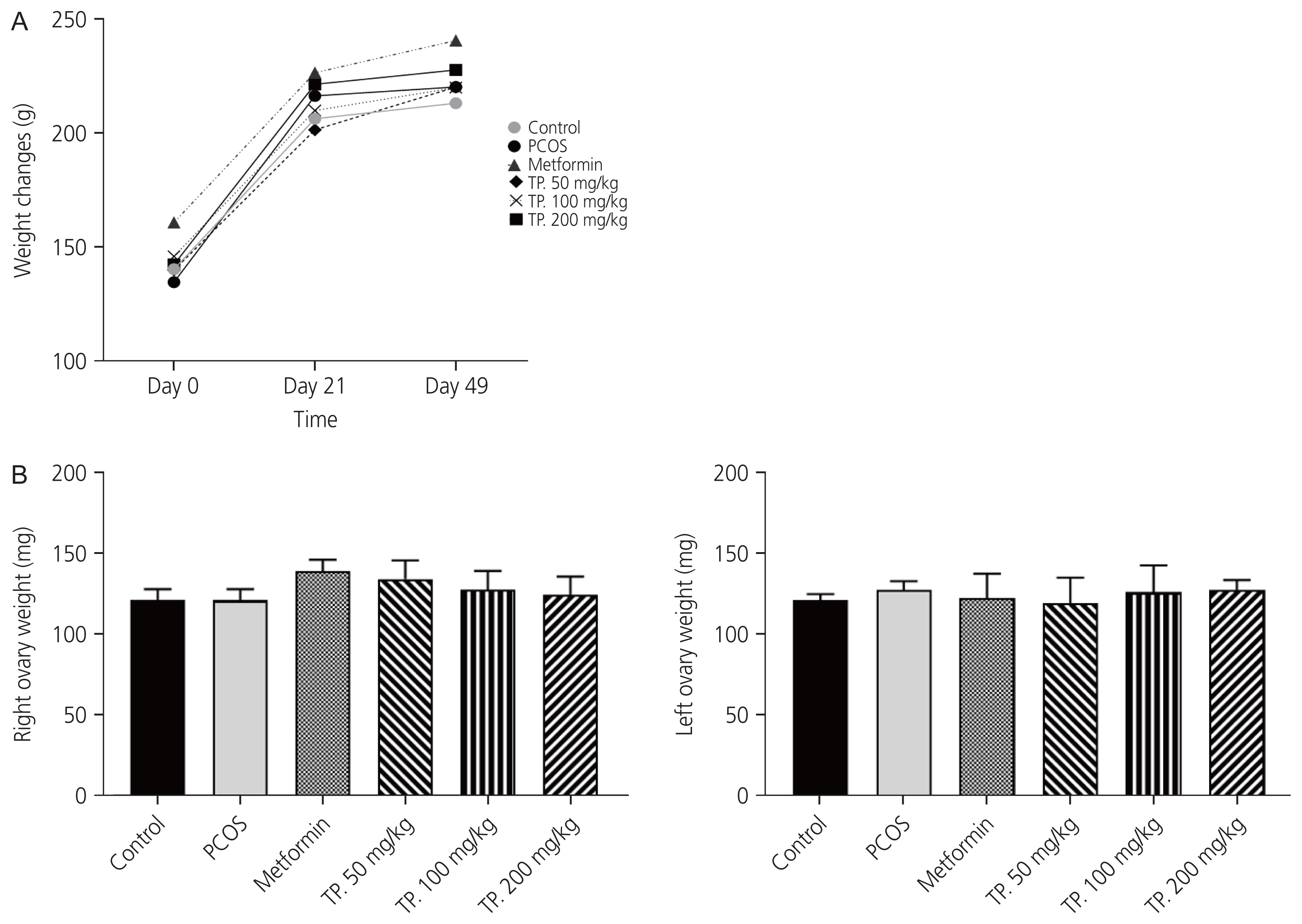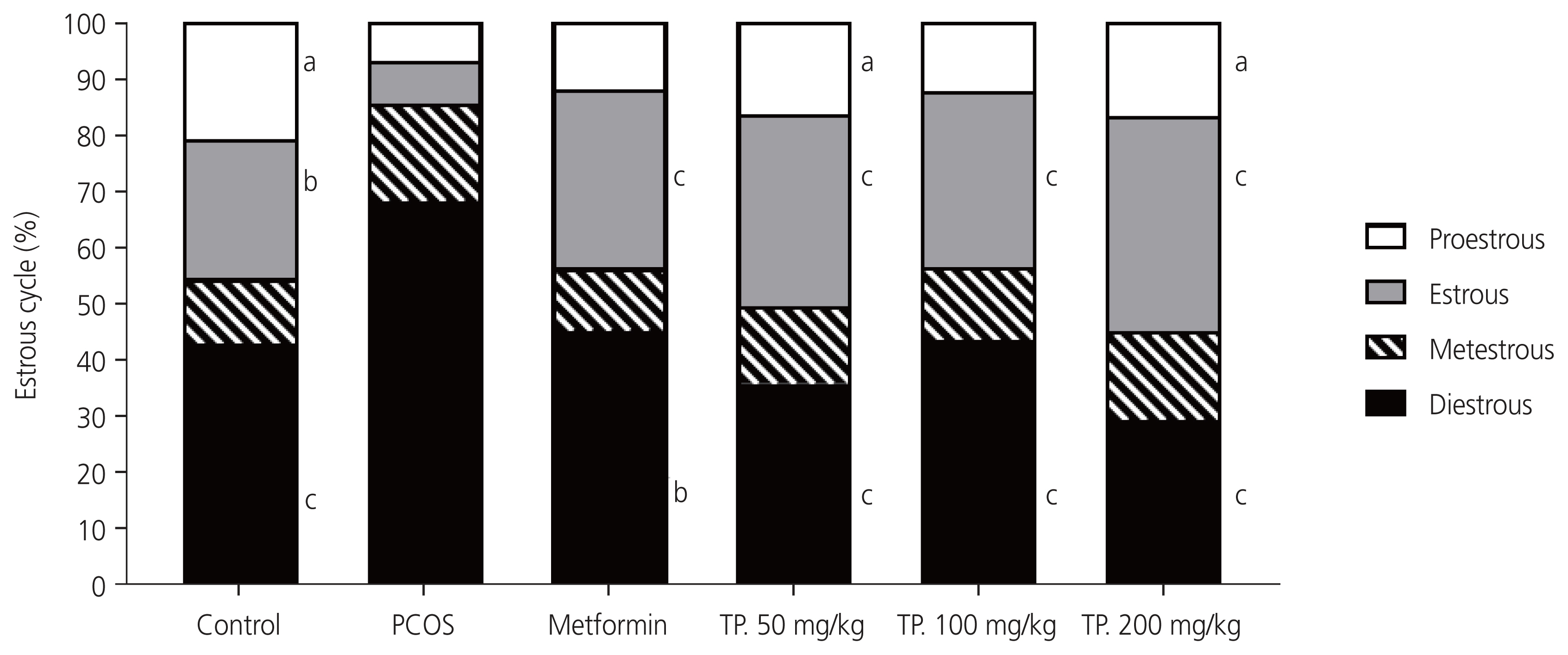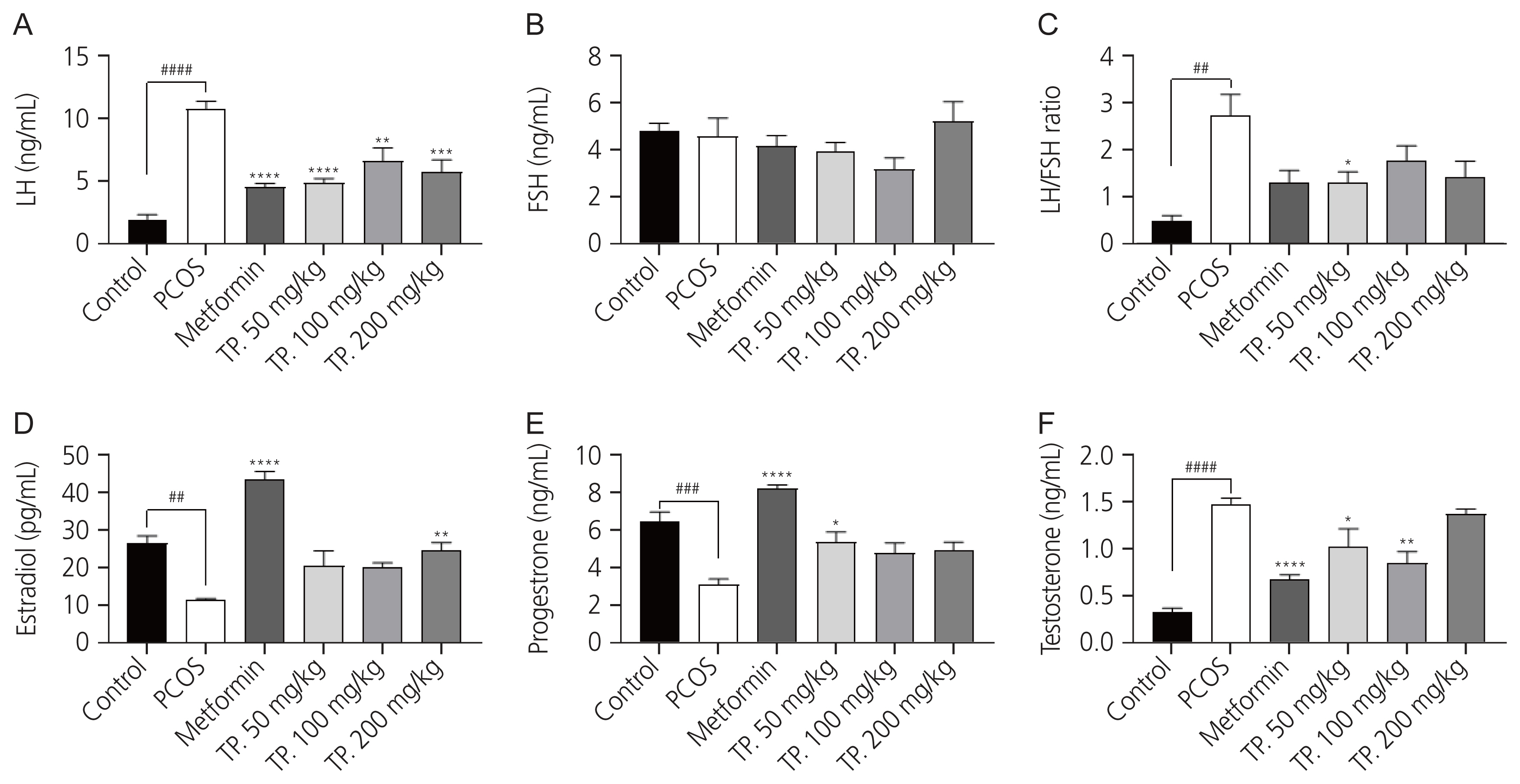Obstet Gynecol Sci.
2023 Mar;66(2):107-117. 10.5468/ogs.22129.
Beneficial effects of Teucrium polium hydroalcoholic extract on letrozole-induced polycystic ovary syndrome in rat model
- Affiliations
-
- 1Traditional Medicine and Materia Medica Research Center and Department of Traditional Pharmacy, School of Traditional Medicine, Tehran, Iran
- 2Student Research Committee, Shahid Beheshti University of Medical Sciences, Tehran, Iran
- 3Department of Traditional Pharmacy and Persian Medicine, Faculty of Pharmacy and Pharmaceutical Sciences, Tehran Medical Sciences, Islamic Azad University, Tehran, Iran
- 4Department of Traditional Medicine, School of Traditional Medicine, Tehran, Iran
- 5Department of Pharmacology and Toxicology, School of Pharmacy, Shahid Beheshti University of Medical Sciences, Tehran, Iran
- KMID: 2540480
- DOI: http://doi.org/10.5468/ogs.22129
Abstract
Objective
Polycystic ovary syndrome (PCOS) is an endocrine disorder that disrupts the menstrual cycle and causes infertility. Considering the increasing use of medicinal plants, the present study aimed to evaluate the effects of Teucrium polium L. on letrozole-induced PCOS in female rats.
Methods
Six groups of rats (n=7 each) were evaluated. The control group received 1% carboxy methyl cellulose as vehicle, while the five other groups received letrozole 1 mg/kg orally for 21 days. After PCOS induction, the rats were orally administered T. polium extract (50, 100, and 200 mg/kg) or metformin (200 mg/kg) for 28 days. Subsequently, body and ovarian weights and serum levels of follicle stimulating hormone, luteinizing hormone (LH), estradiol, progesterone, and testosterone were measured. Finally, the ovarian tissues were isolated for histological examination.
Results
There were no significant changes in weekly body weight in any group. After 21 days of letrozole administration, PCOS induction was confirmed by estrous cycle irregularities and increased LH and testosterone levels. After treatment with the hydroalcoholic extract of T. polium, testosterone and LH levels were significantly reduced in all groups (P<0.05). Histological studies of ovaries in the metformin and T. polium groups exhibited normal follicular development with fewer and smaller cystic follicles than those in the PCOS group.
Conclusion
The hydroalcoholic extract of T. polium improves serum levels of sex hormones, restores ovarian morphology in PCOS-induced rats, and is a good candidate for further clinical trials.
Keyword
Figure
Reference
-
References
1. Walters KA, Allan CM, Handelsman DJ. Rodent models for human polycystic ovary syndrome. Biol Reprod. 2012; 86:1–12.2. Demirel MA, Ilhan M, Suntar I, Keles H, Kupeli Akkol E. Activity of corylus avellana seed oil in letrozole-induced polycystic ovary syndrome model in rats. Rev Bras Farmacogn. 2016; 26:83–8.3. Park CH, Chun S. Influence of combined oral contraceptives on polycystic ovarian morphology-related parameters in Korean women with polycystic ovary syndrome. Obstet Gynecol Sci. 2020; 63:80–6.4. Palomba S, Daolio J, La Sala GB. Oocyte competence in women with polycystic ovary syndrome. Trends Endocrinol Metab. 2017; 28:186–98.5. Mahmoudi R, Kazeminia M, Kaboudari A. Review on composition and antimicrobial effects of teucrium (Teucrium polium L.) grown in Iran and comparison with the around the world. J Babol Univ Med Sci. 2017; 19:54–64.6. Medical Economics. PDR for herbal medicine. Physicians’ desk reference for herbal medicines. Encyclopedia of dietary supplements. 2nd ed.Montvale: Medical Economics Company;2004. p. 603–4.7. Capasso F, Cerri R, Morrica P, Senatore F. Chemical composition and anti-inflammatory activity of an alcoholic extract of Teucrium polium L. Boll Soc Ital Biol Sper. 1983; 59:1639–43.8. Vahidi AR, Dashti-rahmatabadi MH, Bagheri SM. The effect of Teucrium polium boiled extract in diabetic rats. Iran J Diabetes Obes. 2010; 2:27–32.9. Salimnejad R, Sazegar G, Saeedi Borujeni MJ, Mousavi SM, Salehi F, Ghorbani F. Protective effect of hydroalcoholic extract of Teucrium polium on diabetes-induced testicular damage and serum testosterone concentration. Int J Reprod Biomed. 2017; 15:195–202.10. Esmaeili MA, Zohari F, Sadeghi H. Antioxidant and protective effects of major flavonoids from Teucrium polium on beta-cell destruction in a model of streptozotocin-induced diabetes. Planta Med. 2009; 75:1418–20.11. Abadian K, Keshavarz Z, Mojab F, Alavi Majd H, Abbasi NM. Comparison the effect of mefenamic acid and Teucrium polium on the severity and systemic symptoms of dysmenorrhea. Complement Ther Clin Pract. 2016; 22:12–5.12. Abdollahi M, Karimpour H, Monsef-Esfehani HR. Antinociceptive effects of Teucrium polium L total extract and essential oil in mouse writhing test. Pharmacol Res. 2003; 48:31–5.13. Aghili Khorasani Shirazi MH. Moalejat-e aghili. Tehran: Institute of Medical History;3rd ed.Islamic and Complementary Medicine. 2008. p. 305–6.14. Shoorei H, Khaki A, Ainehchi N, Hassanzadeh Taheri MM, Tahmasebi M, Seyedghiasi G, et al. Effects of matricaria chamomilla extract on growth and maturation of isolated mouse ovarian follicles in a three-dimensional culture system. Chin Med J (Engl). 2018; 131:218–25.15. Ndeingang EC, Defo Deeh PB, Watcho P, Kamanyi A. Phyllanthus muellerianus (euphorbiaceae) restores ovarian functions in letrozole-induced polycystic ovarian syndrome in rats. Evid Based Complement Alternat Med. 2019; 2019:2965821.16. Kabiri N, Tabandeh MR, Tabatabaie SR. Beneficial effects of pioglitazone and metformin in murine model of polycystic ovaries via improvement of chemerin gene upregulation. Daru. 2014; 22:39.17. Abtahi-Eivari SH, Moghimian M, Soltani M, Shoorei H, Asghari R, Hajizadeh H, et al. The effect of galega officinalis on hormonal and metabolic profile in a rat model of polycystic ovary syndrome. Int J Women’s Heal Reprod Sci. 2018; 6:276–82.18. Tamadon A, Hu W, Cui P, Ma T, Tong X, Zhang F, et al. How to choose the suitable animal model of polycystic ovary syndrome? Traditional Medicine and Modern Medicine. 2018; 1:95–113.19. Kafali H, Iriadam M, Ozardalı I, Demir N. Letrozole-induced polycystic ovaries in the rat: a new model for cystic ovarian disease. Arch Med Res. 2004; 35:103–8.20. Abbott DH, Barnett DK, Bruns CM, Dumesic DA. Androgen excess fetal programming of female reproduction: a developmental aetiology for polycystic ovary syndrome? Hum Reprod Update. 2005; 11:357–74.21. Moradi N, Bidgoli SA, Chaichian S. Ovarian cysts disappear after 14-day oral regimen of Korean red ginseng extract in letrozole-induced polycystic ovarian syndrome. Obstet Gynecol Sci. 2021; 64:274–83.22. Sun J, Jin C, Wu H, Zhao J, Cui Y, Liu H, et al. Effects of electro-acupuncture on ovarian P450arom, P450c17α and mRNA expression induced by letrozole in PCOS rats. PLoS One. 2013; 8:e79382.23. Rajan RK, M SS, Balaji B. Soy isoflavones exert beneficial effects on letrozole-induced rat polycystic ovary syndrome (PCOS) model through anti-androgenic mechanism. Pharm Biol. 2017; 55:242–51.24. Yang H, Lee SY, Lee SR, Pyun BJ, Kim HJ, Lee YH, et al. Therapeutic effect of Ecklonia cava extract in letrozole-induced polycystic ovary syndrome rats. Front Pharmacol. 2018; 9:1325.25. Bednarska S, Siejka A. The pathogenesis and treatment of polycystic ovary syndrome: what’s new? Adv Clin Exp Med. 2017; 26:359–67.26. Palomba S, Giallauria F, Falbo A, Russo T, Oppedisano R, Tolino A, et al. Structured exercise training programme versus hypocaloric hyperproteic diet in obese polycystic ovary syndrome patients with anovulatory infertility: a 24-week pilot study. Hum Reprod. 2008; 23:642–50.27. Orio F, Giallauria F, Palomba S, Manguso F, Orio M, Tafuri D, et al. Metabolic and cardiopulmonary effects of detraining after a structured exercise training programme in young PCOS women. Clin Endocrinol (Oxf). 2008; 68:976–81.28. Rashed MM, Shallan M, Mohamed DA, Fouda K, Hanna LM. Biological evaluation of anti-androgenic effect of some plant foods. J Food Nutr Res. 2014; 2(Suppl 9):645–51.29. Bovee TF, Schoonen WG, Hamers AR, Bento MJ, Peijnenburg AA. Screening of synthetic and plant-derived compounds for (anti)estrogenic and (anti)androgenic activities. Anal Bioanal Chem. 2008; 390:1111–9.30. Saini RK, Song MH, Yu JW, Shang X, Keum YS. Phytosterol profiling of apiaceae family seeds spices using GC-MS. Foods. 2021; 10:2378.31. Al-Tikriti A, Al-Khateeb E, Abbas MA. Teucrium polium hexane extract downregulated androgen receptor in testis and decreased fertility index in rats. Hum Exp Toxicol. 2017; 36:1248–55.32. Nasri S, Orian SH, Haeri Rohani A, Amin GH, Naghizadeh MA. The effects of vitex agnuscastus L. Extract and interaction with bromocriptine on luteinizing hormone and testosterone in male mice. Hormozgan Med J. 2005; 9:113–8.33. Swaroop A, Jaipuriar AS, Gupta SK, Bagchi M, Kumar P, Preuss HG, et al. Efficacy of a novel fenugreek seed extract (trigonella foenum-graecum, furocyst) in polycystic ovary syndrome (PCOS). Int J Med Sci. 2015; 12:825–31.34. Saadia Z. Follicle stimulating hormone (LH: FSH) ratio in polycystic ovary syndrome (PCOS) - obese vs. non-obese women. Med Arch. 2020; 74:289–93.35. Chaudhari N, Dawalbhakta M, Nampoothiri L. GnRH dysregulation in polycystic ovarian syndrome (PCOS) is a manifestation of an altered neurotransmitter profile. Reprod Biol Endocrinol. 2018; 16:37.36. Kamel HH. Role of phyto-oestrogens in ovulation induction in women with polycystic ovarian syndrome. Eur J Obstet Gynecol Reprod Biol. 2013; 168:60–3.37. Johnson N. Metformin is a reasonable first-line treatment option for non-obese women with infertility related to anovulatory polycystic ovary syndrome--a meta-analysis of randomised trials. Aust N Z J Obstet Gynaecol. 2011; 51:125–9.38. Iervolino M, Lepore E, Forte G, Laganà AS, Buzzaccarini G, Unfer V. Natural molecules in the management of polycystic ovary syndrome (PCOS): an analytical review. Nutrients. 2021; 13:1677.39. Ke J, Duan R. Effects of flavonoids from semen cuscutae on the hippocampal-hypothalamic-pituitary-ovarian sex hormone receptors in female rats exposed to psychological stress. Clin Exp Obstet Gynecol. 2013; 40:271–4.40. Guo XD, Diao QY, Wang YY, Tu Y, Deng KD, Wang XJ, et al. The effect of administration of rutin on plasma levels of estrogen, prolactin, growth hormone and gene expression of their receptors in mammary glands in ovariectomized rats. J Integr Agric. 2012; 11:1700–6.41. Peng F, Hu Y, Peng S, Zeng N, Shi L. Apigenin exerts protective effect and restores ovarian function in dehydroepiandrosterone induced polycystic ovary syndrome rats: a biochemical and histological analysis. Ann Med. 2022; 54:578–87.42. Rezvanfar MA, Rezvanfar MA, Ahmadi A, Saadi HA, Baeeri M, Abdollahi M. Mechanistic links between oxidative/nitrosative stress and tumor necrosis factor alpha in letrozole-induced murine polycystic ovary: biochemical and pathological evidences for beneficial effect of pioglitazone. Hum Exp Toxicol. 2012; 31:887–97.43. Gülçin I, Uguz MT, Oktay M, Beydemir S, Küfrevioglu ÖI. Antioxidant and antimicrobial activities of Teucrium polium L. J Food Tech. 2003; 1:9–17.
- Full Text Links
- Actions
-
Cited
- CITED
-
- Close
- Share
- Similar articles
-
- Histologic comparison of polycystic ovary syndrome induced by estradiol valerate and letrozole
- Stereological study of the effects of letrozole and estradiol valerate treatment on the ovary of rats
- Medical diagnosis and treatment of polycystic ovary syndrome
- Recent Treatment Strategies for Polycystic Ovary Syndrome
- The Efficacy of Letrozole in Women with a Poor Endometrial Response to Clomiphene Citrate






